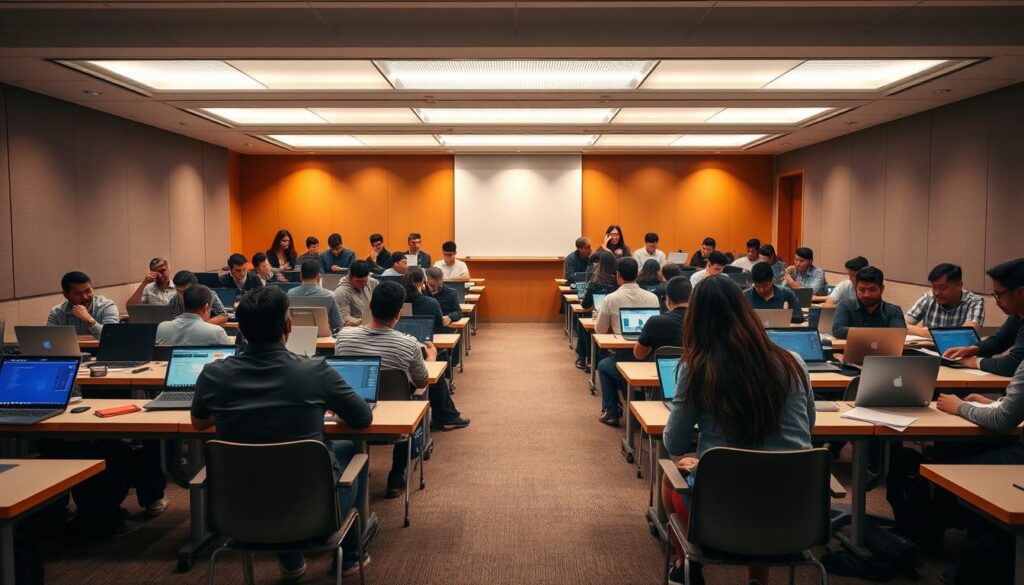Now Reading: The Impact of DeFi Regulatory Risks on Investments
- 01
The Impact of DeFi Regulatory Risks on Investments
The Impact of DeFi Regulatory Risks on Investments

The rise of blockchain-based financial tools has reshaped how people manage assets. Over $247 billion now flows through these systems, marking a 1,700% surge in just one year. This explosive growth brings both opportunities and challenges for investors seeking alternatives to traditional markets.
New protocols enable users to trade tokens and access liquidity without middlemen. However, this innovation comes with complexities. A recent BIS study shows how market stability depends on proper safeguards as these systems evolve. Over $12 billion in losses since 2020 highlights the need for better security measures.
Investors face unique hurdles when navigating this space. Traditional financial rules often don’t apply to smart contracts or tokenized assets. This mismatch creates uncertainty that impacts market behavior and asset values. Companies developing these technologies must balance innovation with user protection.
Key Takeaways
- Blockchain financial systems handle $247 billion in assets despite security concerns
- Investor losses exceed $12 billion since 2020 due to protocol vulnerabilities
- Market liquidity fluctuates with changing compliance expectations
- Smart contract technology outpaces existing oversight frameworks
- Token values respond sharply to governance discussions
The industry’s future depends on creating reliable tools for risk management. As more people adopt these services, transparent protocols become essential for maintaining trust. Understanding these dynamics helps investors make informed decisions in fast-changing markets.
Understanding the DeFi Landscape
Blockchain innovation forms the backbone of modern financial systems, enabling peer-to-peer transactions without traditional gatekeepers. This technology stacks multiple layers to create transparent, automated services that redefine asset management.

The Rise of Blockchain Technology
At its core, blockchain provides an unchangeable ledger that records transactions across decentralized networks. Five key layers power these systems:
- Consensus layer: Base networks like Ethereum validate transactions
- Protocol layer: Smart contracts automate lending or trading
- Application layer: User-friendly platforms for crypto activities
- Aggregation layer: Combines services for smoother experiences
- Exchange gateways: Bridges between crypto and traditional money
These layers work together to eliminate middlemen. For example, automated market makers use smart contracts to pool liquidity from thousands of users.
Emerging Trends in Decentralized Finance
New tools let people earn yields through liquidity mining or algorithmic trading strategies. Over 80% of crypto assets now flow through permissionless protocols.
Scalability improvements reduce transaction costs, while intuitive interfaces attract mainstream users. However, interconnected systems mean technical issues in one protocol can ripple across entire networks.
Defining Decentralized Finance (DeFi)
Digital finance has evolved beyond traditional banking systems through open-source protocols. These systems enable direct peer-to-peer transactions using blockchain networks instead of centralized institutions.

Key Characteristics and Functions
Permissionless access lets anyone with internet connectivity use financial tools without approval. Trustless operations mean transactions execute automatically through code rather than third-party verification. This removes gatekeepers but requires rigorous smart contract audits.
Public ledgers provide full transparency for all activities. Account pseudonyms protect user identities while maintaining transaction visibility. These features create new opportunities for global participation in financial markets.
Core protocols replicate essential services through automation:
- Lending platforms match borrowers with lenders algorithmically
- Decentralized exchanges pool liquidity from thousands of contributors
- Synthetic assets mirror traditional investments through tokenization
Protocol composability allows different systems to combine like building blocks. This “money Lego” effect enables complex strategies but increases exposure to cascading errors. Investors must understand how interconnected tools affect asset security and market behavior.
Emerging solutions address these challenges through improved contract designs. Multi-chain architectures enhance scalability while maintaining core principles of decentralization. As the space matures, balancing innovation with reliability remains critical for sustainable growth.
Navigating DeFi Regulatory Risks
Global financial systems face new challenges as decentralized protocols operate outside traditional oversight. Current rules like Europe’s MiCA framework struggle to govern borderless blockchain networks effectively. This gap leaves investors balancing innovation against potential legal shifts.

- Holding developers accountable for code creation
- Regulating decentralized autonomous organizations
- Monitoring specific financial activities
- Building supervision into blockchain architecture
Jurisdictional conflicts complicate matters further. A transaction initiated in Texas might involve protocols based in Singapore and users in Brazil. Market values swing as traders guess which rules might apply tomorrow.
Some countries ban certain services while others encourage experimentation. This patchwork forces investors to map regional policies before allocating funds. The threat of retroactive rule changes adds another layer of complexity to understanding crypto volatility.
Forward-thinking teams now design protocols with adaptable governance features. These systems allow gradual adjustments as legal expectations evolve. While solutions like embedded supervision remain theoretical, they hint at potential middle ground between innovation and accountability.
The Role of Smart Contracts in DeFi
Self-executing agreements built on blockchain networks have revolutionized how financial systems operate. These tools automate transactions through code, replacing manual processes with transparent, tamper-proof protocols. Their ability to enforce terms without intermediaries makes them foundational to modern financial innovation.
How Automation Redefines Financial Processes
Smart contracts eliminate human error by executing predefined conditions instantly. For example, lending platforms use this technology to adjust interest rates based on real-time supply and demand. Liquidations trigger automatically if collateral values drop, protecting lenders while maintaining market stability.
Transforming Lending and Trading Systems
Decentralized exchanges rely on these automated systems to pool liquidity from global users. Traders swap tokens directly through secure protocols, bypassing centralized custodians. Platforms like Uniswap demonstrate how smart contracts reshape financial services by enabling peer-to-peer transactions at scale.
Investors now access sophisticated strategies like flash loans and yield optimization through programmable agreements. While these tools offer efficiency, their irreversible nature demands rigorous code audits. Understanding how automated protocols function remains critical for navigating this evolving landscape safely.
FAQ
How does blockchain technology influence decentralized platforms?
Blockchain acts as the backbone for decentralized platforms, enabling transparent, tamper-proof transactions without intermediaries. Public ledgers track every action, creating trust in systems like Ethereum or Solana.
What makes decentralized finance different from traditional banking?
Unlike banks, decentralized platforms operate without central control. Tools like Compound or Aave let users lend or borrow crypto assets directly through code-driven protocols, removing middlemen and reducing fees.
Why are smart contracts critical for automated lending services?
Smart contracts on networks like Ethereum execute agreements automatically when conditions are met. For example, MakerDAO uses them to manage collateralized loans, ensuring instant settlements and minimizing human error.
Can decentralized exchanges face security issues?
Yes. Platforms like Uniswap rely on liquidity pools, which hackers sometimes exploit through vulnerabilities like flash loans. Users must research projects and use audited protocols to mitigate these threats.
How do liquidity pools impact token values?
Liquidity pools on platforms such as Curve Finance stabilize prices by balancing supply and demand. Low liquidity can cause volatile price swings, making it harder to trade tokens at fair rates.
What safeguards exist against rug pulls in crypto projects?
Audits by firms like CertiK or ChainSecurity help identify malicious code. Community-driven platforms like SushiSwap also use multi-signature wallets to prevent developers from draining funds unexpectedly.















